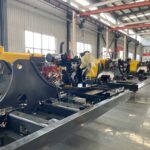Introduction
Piledrivers are industrial heavy machinery used to drivePile foundations deep into the ground to support structures with immense weight-bearing requirements like bridges, highrises, dams, and other major projects. However, understanding the right piledriving methods for different geotechnical conditions along with the costs/benefits versus alternatives is key for construction success.
This blog post unravels the mystery around effective piledriver use in major infrastructure projects. We explore the types of piledriving equipment, innovative monitoring methods, ideal applications, safety best practices, and advantages piles offer over other foundation options.
Piledriver Types and Methods

There are two primary categories of piledrivers based on the technique used to drive piles:
- Impact Drivers – Utilize a heavy ram powered by hydraulics or cables to pound the pile into the ground through repeated high-energy impacts.
- Vibratory Drivers – Use an electrically or hydraulically powered oscillating clamp to disturb the soil and allow the pile to sink through vibrations rather than hammering.
Table 1 compares the main specifications between these piledriver varieties:
| Fonctionnalité | Impact Driver | Vibratory Driver |
|---|---|---|
| Typical Size | 30 – 100 tons | 10 – 50 tons |
| Drive Method | Dropping weight | Clamp vibrations |
| Pros | High capacity, all soil types | Low noise/vibration, continuous |
| Cons | Higher cost, noise, vibration | Lower capacity, some soils |
Precision Driving Through Monitoring

Modern piledrivers utilize advanced sensors, data feeds, and digital interfaces to carefully control the pile driving process in real time, including:
- Penetration Rate Monitoring – Optimizes impact or vibration frequency based on soil conditions
- Drive Energy Measurement – Ensures hammer is transferring sufficient force to pile top
- Subsurface Profiling – Logging of soil density changes throughout layers
- Bearing Capacity Validation – Confirms target load capacity is achieved
This technology gives operators unprecedented visibility into soil behavior for precision pile installation.
piledriver construction:Unlocking New Possibilities
Pile foundations enabled by piledrivers unlock construction possibilities unachievable using standard foundations, such as:
Skyscrapers & Towers – Fast high-capacity foundations to anchor tall buildings in space-constrained locations
Bridges Over Water – Enables structurally robust bridge piers planted deep beneath rivers/oceans
Wind Turbines & Oil Rigs – Secure anchoring of towers in offshore locations with deep pile footings
Tunnels & Mines – Reinforcing vertical access shafts and underground passages susceptible to subsidence
Seawalls & Jetties – Holding back tons of hydraulic pressure from waves/tides on harbor structures
Seismic & Extreme Climates – Durable anchoring able to withstand severe earthquakes, storms, or permafrost
Piledriving Best Practices
Efficient, safe piledriving relies on contractors following certain best practices:
- Detailed Geotech Surveys – Accurate ground profiling guides equipment selection and methodology
- Pre-Driving Pile Assembly – Enables faster installation by pre-welding or splicing pile segments
- Templating & Alignment – Precisely positioning piles before driving prevents time-wasting adjustments
- Vibration Monitoring – Prevent damage to existing nearby structures through real-time sensors
- Access Route Planning – Establish safe equipment and material staging areas around site
Conclusion
In summary, piledrivers provide unmatched capabilities for installing deep high-capacity foundations in cases where standard footings fail. While the pile driving process appears mystifying, advanced monitoring technology along with proper planning, preparation, and geotechnical analysis enables precision results. When geotech engineering and construction expertise combine forces, piledrivers can safely unlock previously impossible structural achievements.
FAQ
Here are some common questions about piledriver foundation construction:
How are pile bearing capacities predicted before driving?
Engineers use soil sampling and lab testing to create site geotechnical profiles modeling the ultimate pile capacities expected based on the soil/rock layers.
What inspection methods check pile integrity after installation?
Sonic echo or low-strain impact testing validates proper pile setup by measuring reflections of hammer impacts off the pile bottom. This identifies any subsurface defects.
How much load can a single pile support above ground?
Depending on soil conditions and depth, a single pile can handle 500-1000+ tons in capacity. But grouped piles often support 10,000+ ton structures.
What are signs of potential problems during pile driving?
Issues like slow penetration rates, excessive vibration, pile damage, strange noises, or tilting indicate problems requiring investigation before progressing further.
How long does driving a single pile take for an experienced crew?
With proper geotech surveying, site prep, equipment selection, and crew experience, most piles reach target depth within 15 minutes or less.






-150x150.webp)
